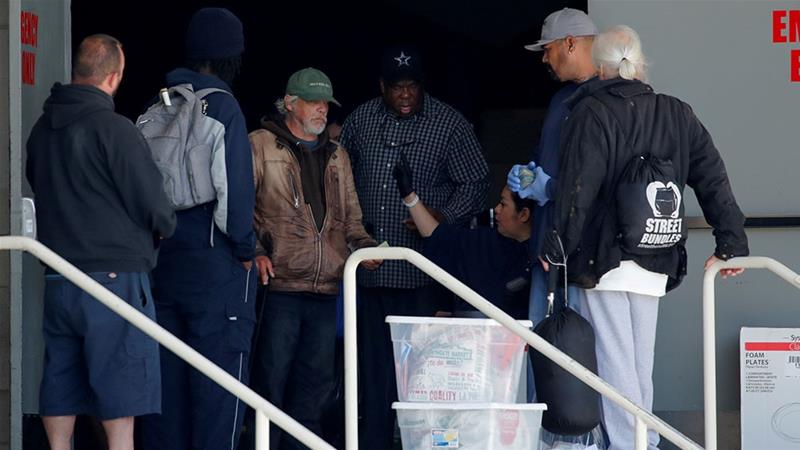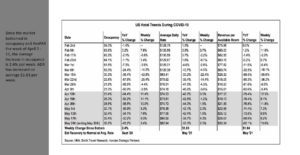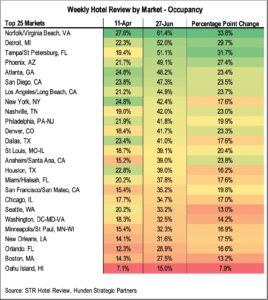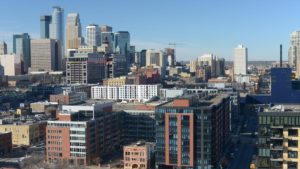We at HSP are following the news closely and keeping up with the potential impacts the pandemic will have on various industries. This week, we are focusing on the use of convention facilities as care units. We found the following article published on AsumeTech particularly insightful:
Inside the US’s Coronavirus Convention-Centre Homeless Shelters
Written by Tammy Waldman
Published on May 4, 2020
Portland, Oregon – Outside the Oregon Convention Center (OCC) in downtown Portland, Oregon, sits a mobile shower with a wheelchair lift and a cigarette smoking shelter in which the huge structure’s brand-new, short-lived locals sit shoulder-to-shoulder.
Inside, people pass the hours, lying or sitting in numbered, military- design green cots, in a shared main sleeping location divided by tape and hanging blue drapes. Homeowners state there is an eating location, big folding tables, chairs tipped approximately show they have actually been sanitised and a single TELEVISION, whose remote control, a local stated, is kept by personnel. No visitors are permitted inside; coloured adhesive bracelets are inspected at the front door. Authorities at OCC declined Al Jazeera’s ask for a trip.
“The vibes are pretty good for the most part,” stated 19- year-old OCC homeowner Logan Staggs. “They provide everything you need.”
There is one information that Staggs dislikes, nevertheless: the star-like constellations of small LED lights in the ceilings.
“When I first went in there, the lights creeped me out,” Staggs stated. “There’s no windows, so it can mess with your body clock.”
Logan Staggs stands outside the Oregon convention centre homeless shelter [Thacher Schmid/Al Jazeera] [Daylife]
For locals the convention-centre homeless shelters that have actually turned up throughout the United States given that the coronavirus hit, those lights can symbolise the spacious scale and surreal nature of their environments – extraordinary, unforeseeable, and brought by a pandemic.
“It’s just a jillion lights,” stated Kathleen Mortensen, 62, in San Diego Convention Center (SDCC). “There is a resemblance to stars.”
Warif Rahemtulla, 60, who is remaining in the Fort Worth Convention Center (FWCC), stated the lights assist him unwind. “It’s like looking at the sky,” Rahemtullaadded “If I can’t sleep, I look up, and I’m like wow, man. It’s pretty cool.”
As the effect of the coronavirus grew extreme in March, convention centres axed shows and occasions that would have generated billions of dollars. Homeless shelters likewise started to close as they might not satisfy social distancing standards. Homeless service systems, dealing with public health authorities, hoped that reconditioning the convention centers into “non-congregate” shelters would enable higher physical distancing. Around the nation, they moved countless people into an unidentified variety of shelters in convention centres, a lot of them structures with glimmering glasswork and sensational premises. While authorities state the method marked their best choice for reducing COVID-19’s results on the homeless population, critics fear that such huge endeavors might rather put them in the coronavirus’s crosshairs.
Shelter recommendations
The Federal Emergency Situation Management Authority (FEMA) has actually gotten demands from 31 states and one Native people for an overall $1.2 bn in funds for “for eligible activities including but not limited to non-congregate sheltering”, the company stated.
FEMA informed Al Jazeera the funds are for “health- and medical-related needs” and “may include” unhoused people, however the company would not state how the $1.2 bn was particularly designated.
It is not clear how a lot of these shelters sit inside convention centres. FEMA “does not track” the number or places of homeless shelters it is moneying inside convention centres, a representative stated. FEMA referred Al Jazeera to the Real Estate and Urban Advancement company, which did not react to ask for comment.
MORE THAN 800 HOMELESS PEOPLE ARE PROTECTED IN THE SAN DIEGO CONVENTION CENTER, AND APPROXIMATELY 1,500 MIGHT SHELTER THERE THROUGHOUT THE BREAK OUT. —– GARY WARTH (@GARYWARTHUT) APRIL 8, 2020
The convention centre in San Diego alone holds 1,135 and is growing, while about 328 people usually sleep in the FWCC and 120 in Oregon.
A Lot Of the “federal medical sites” for coronavirus might likewise be comprehended as de facto homeless shelters.
Inside Boston’s convention centre, at the Boston Hope medical centre for people recuperating from COVID-19, more than half, or 97, of its 187 clients are homeless, according to Chief of Health and Person Solutions Marty Martinez.
The huge bulk of those residing in the convention centres are recommendations from existing shelters, though some shelters, such as SDCC, later on opened their doors to unsheltered homeless people. All of the centres need health screenings at consumption. Homeowners should use adhesive wristbands and are permitted to leave.
In turn, locals are supplied with catered food, according to almost a lots locals who spoke with Al Jazeera from the San Diego, Portland and Fort Worth convention-centre shelters.
“The food can’t be beat,” David, a 70- year-old homeowner of the OCC shelter who declined to offer his surname, informed Al Jazeera. “I haven’t eaten this good for fdecades.”
Public health issues
Little is simple in these shelters. Authorities utilized the Las Vegas, Nevada, convention centre’s car park to offer”shelter” In Cincinnati, Ohio, pink yoga mats were utilized as beds. In Oregon, Texas and California, locals oversleep centers that can cover 14 city obstructs.
“This is all new and somewhat strange,” stated Denis Theriault, representative for the OCC. A website lead and just recently employed former information analyst there, Peter Tiso, stated, “we’ve been learning a lot.”
Public health professionals have actually revealed issue over the convention centreshelters Dr Margot Kushel, director of the University of California San Francisco centre for Susceptible Populations, stated the concept these shelters avoid infections is “magical thinking”.
“You’re sharing bathrooms,” Kushel informed Al Jazeera. “You can’t keep people six feet (1.8 metres) away.”
Homeless people get settled in a momentary car park shelter at Cashman Center, with areas marked for social distancing to assist slow the spread of coronavirus illness (COVID-19) in Las Vegas, Nevada, [Steve Marcus/Reuters]
Eric Tars, legal director at the National Law Center on Homelessness and Hardship, concurred.
“Every one of these facilities is on its face violating the CDC’s guidance to avoid large gatherings,” he stated.
The homeless population has a high occurrence of what doctor call “comorbidities”: threat elements such as existing major illness, psychological health battles or dependencies that make them especially susceptible, professionals state.
Svenn-Erik Mamelund, a public health specialist in Norway, stated socioeconomic status has actually long been ignored in public health actions. His research study of deaths in the 1918-1919 influenza pandemic discovered “the first wave hits the poor, the second wave hits the rich.”
“I’m actually, actually worried that in the end, it will be the poorest areas of society that will pay the highest problem from [coronavirus] death, as we have actually seen back in history,” Mamelund stated.
SDCC just recently saw its first 2 favorable COVID-19 tests, while FWCC has actually had 5, however currently has none. At OCC, county authorities declined to share numbers. None has actually had break outs, however there have actually been break outs in some homeless shelters, consisting of one in the Seattle location put up to decrease crowding.
In Portland, David stated, coughing is “out of control”.
If they have a “new,” “worsening,” or “different” cough,
OCC shelter representative Theriault stated that locals are referred to motels for seclusion.
While the centres are not perfect, public health professionals yield there is no easy option.
“It’s almost impossible to manage the crisis of homelessness in a pandemic,” Kushel stated.
Best choice?
In the convention centre shelters, regional authorities compete that the centers are the best choice offered the scenarios.
“They were already in our shelters, so we had to take quick action to make sure the physical distancing was being met,” stated Ashley Bailey, a San Diego city representative. “So, the convention centre is the best option.”
Authorities have actually established handwashing stations and mobile showers, employed personnel, added screening treatments, transport to hotels, and seclusion programs. They stated they have actually been doing the best they can to keep susceptible people – and the whole population – safe.
“This is what they’re used to,” stated Richard Zavala, director of Parks and Rec at the City of Fort Worth, in charge of the FWCC shelter. “We’re only temporary, we’re not going to operate on a permanent basis. We don’t want to institutionalise it.”
Theriault stated “the best public health practice would be for people to have homes” and “anything else we come up with is our best harm reduction approach.”
William Keith stands outside the San Diego Convention Center [Courtesy of San Diego activist Amie Zamudio]
Federal real estate authorities concur, stating “private individual rooms” are the favored pandemic homeless safeguarding method, while “shared spaces” are the least perfect.
In Fort Worth, 39 RV-housed people who have actually evaluated favorable for COVID-19; 10 Recreational vehicles offer seclusion. In Portland, 17 people remain in 2 hotel seclusion programs. San Diego is using hotel spaces to some, Bailey states, “but that setting is not ideal for everyone.”
Zavala draws his experience from handling cyclone shelters, he stated. Whereas SDCC and OCC locals can remain throughout the day, Zavala’s gets locals up, feeds them breakfast burritos and gets them outside by 7am. They can return at 4pm.
There are other distinctions. In Portland, couples can press cots together; FWCC and SDCC different genders. 4 months pregnant, Lori Pena left bed 126 in San Diego due to the fact that she was not permitted to be near her partner.
“I want to protect my pregnancy,” Pena, 34, stated. “We’re trying the best we can right now to stay together and keep our little family safe.”
It is not clear how long these convention-centre shelters will be open. Conventional shelters are frequently carefully spaced, and can not go back to capability up until social distancing standards are no longer in location. “It’s the local and state health departments that are really running the show,” the University of California San Francisco’s Dr Kushel stated.
In Texas, the first stage of the guv’s resuming strategy took result on Friday. Zavala quotes the Fort Worth centre’s shelter will be open another month or more.
“All depends on governor orders, moreover pandemic trends and health professionals,” he stated.
It likewise might depend upon the greatest unknown of all: the 30 million recently out of work Americans. The number of will lose their real estate, and how much could the existing figure of a half- million homeless grow, particularly in states and cities currently dealing with cost effective real estate crises?
In spite of difficulties and staying concerns, authorities are positive, and locals have actually likewise discovered cause for appreciation.
In San Diego, Mortensen stated, fresh laundry is put in plastic bags on cots by 2pm everyday, and “they don’t lose a sock.” In Portland, “we all just kind of support each other,” stated Rubin, 23, declining to offer a surname.
” This [pandemic] is the worst experience of my life. I’m going through hell, actually,” stated Rahemtulla, who is utilized and has strategies to return into real estate. “If it wasn’t for the convention centre, I don’t know what I’d do.”



